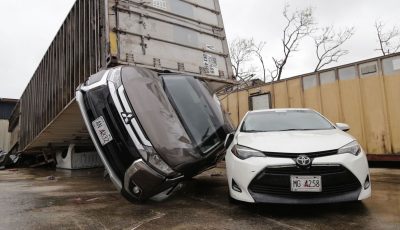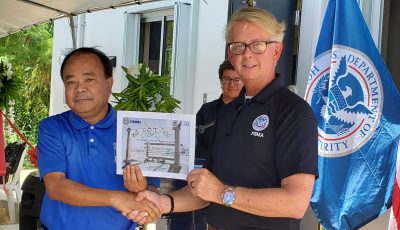CUC: 2 to 3 months for power
Commonwealth Utilities Corp. officials on Friday gave full power restoration a timeline of two to three months, briefing reporters on Friday about their strategy to reenergize all of the island’s main feeders within eight weeks. From the main feeders, they will continue into the laterals of the island, aiming to keep materials and linemen at sufficient levels to keep up with their day-in, day-out pace.
Since Typhoon Soudelor hit almost a month ago, CUC and regional utility partners aiding with the typhoon recovery have worked 12-hour days, six days a week, and have installed about 200 power poles.
When asked Friday if Saipan would have all its light back on by December—or Christmas time—CUC Power Division manager Gary Camacho said, “Absolutely.”
“Buy your [Christmas] lights today,” he added.
Camacho on Friday described their strategy of keeping labor, equipment, and materials all at the same levels so they do not have “one run out the other.”
He said they have been working closely with the Federal Emergency Management Agency to do this, bringing in private groups from Guam and public utility crew from regional islands like Palau, Yap, and Federal States of Micronesia, among others.
“Contracts have been prepared already and requests have gone up to Homeland for assistance in shipping some of their equipment over,” he said.
“We believe we are on target considering the resources that we have,” Camacho said.
Things are going to take off quicker once the main systems, or feeders, are turned on. When they do restore power to the main feeders, CUC’s plan is to have as many people assisting as things may get more complicated combing up the laterals of the island and into the landscape.
Visual inspection has shown about 800 power poles were damaged, according to Camacho. But this could grow.
“The ideal is to move as quickly as we can along the laterals on each feeder, as they start from the power plant out,” Camacho said.
CUC has brought back power to certain parts of Garapan—the economic hub of the island.
Feeder 1, 2, and 3, which comprise parts of the Garapan tourist district, have some power. Feeder 2 runs from Lower Base through Smiling Cove into Garapan down to the Toyota intersection on Beach Road. It is currently without power.
Feeder 3, which runs from CUC’s Power Plant 4 down to Chale Pale Arnold Road, and down to Chalan Monsignor Road to the intersection in the As Lito/Dandan area near CUC’s Dandan office, is also not yet energized.
Feeder 4 is energized to Kagman only because it was the least damaged by the storm, Camacho said.
Camacho said when the storm hit, the island’s primary power poles, or the nine poles from the substation that feed the southern end of the island, were destroyed.
Some of the island’s critical areas—from the airport, the hospital, the water wells, to CUC substations—had systems that were also destroyed.
“We really had to expend a lot of time and resources to be able to get them at the stage they are at today,” he said, noting that they are still dependent on the “flow-in” of materials.
“I’m pretty confident that at the rate we are going, we should be able to get a lot of these feeders restored within eight weeks,” Camacho said.
He said at their current rate, they expect Feeder 1’s secondary laterals restored within the next month.
For Feeder 2, Camacho said, they have power poles up and are going to frame them and restore power within the next couple of weeks.
For Feeder 3, Camacho said, the “mains” are on and they aim to energize the laterals within the next month.
Feeder 4 has mains on all the way down to Kagman, Camacho said. He expects its laterals to have power within next month.
“We can get a good significant amount of the laterals energized—not all—but a good amount,” Camacho said.
Friday’s press conference was CUC’s first news briefing since Soudelor hit nearly a month ago. The Inos administration and FEMA had been coordinating their own to give power, water, and recovery updates as information flowed to them.
FEMA federal coordinating officer Stephen DeBlasio, who was part of the meeting on Friday, said Typhoon Soudelor rivaled major catastrophic events in the U.S. mainland and thanked the U.S. Army Corps of Engineers for their help.
The Army Corps was “mission-assigned” by FEMA to aid CUC in recovery efforts. Their 249th Engineering Battalion, a power generation crew, has a team on island that follows utility crew across the island.
DeBlasio said this was the first time he has seen FEMA utilize the 249th Battalion.
“These are guys and gals climbing the poles and following behind CUC crews and making the connections, installing some of the hardware,” he said, describing them “heroes.”
DeBlasio said this team is on island for a minimum 30 days but he will press to keep them on board, as long CUC needs them.
“I’ve been involved in Katrina, I’ve been involved in 9/11, I’ve been involved in the hurricane season in 2004, and Irene in the northeast and I can tell you the devastation here on this small island rivals anyone of those events.”
“This is a heavy lift,” he added.
Acting CUC executive director John Riegel praised the comeback ability of the CNMI. “We recognize the hardship that everyone is living under, without water, without power, but we really appreciate the patience that the community has shown,” Riegel said.
CUC has brought Power Plant 4 online with 4.8 megawatts of electricity, powering the hospital, the Sadog Tasi wastewater plant, and other limited areas.
As of last Friday, all wastewater lift stations are operating.
Typhoon Soudelor brought down both power plants 1 and 4. FEMA has provided dozens of generators to power water pumps across the island.
Wastewater side of the utility was unharmed. With power generation and transition down, wastewater treatment plants just lost power.
There was no damage structurally to CUC’s wastewater plant. FEMA brought in a generator to bring power back to the Sadog Tasi wastewater plant, allowing CUC to do secondary treatment of waste flow. As of last Friday, CUC’s power crew have brought back “line power” to the plant, Riegel said.
He also noted that since the typhoon hit, they’ve only had reports of two “back ups,” or sewage overflow, acknowledging wastewater crew for keeping that in control.
He said CUC and the U.S. Army Corps strategically selected locations across island to set up generators to reenergize water pumps. This required CUC and the Army Corps to do some water line testing first.
When trees topple over, they sometimes lift up mains and service lines, resulting in leaks, Riegel said. Rather than waste the precious water they had, lines were tested before reenergizing the water pumps.
CUC brought back water to all villages over the weekend, at limited hours.
“From this point forward, we are going to see regular increases. As Gary is extending main to the wells, we’ll be able to energize more wells. That’ll provide more water, that’ll be able to extend our water hours, and eventually we’ll be back at normal.”
CUC has 145 wells. Only 56—or a third of them—are running.



























